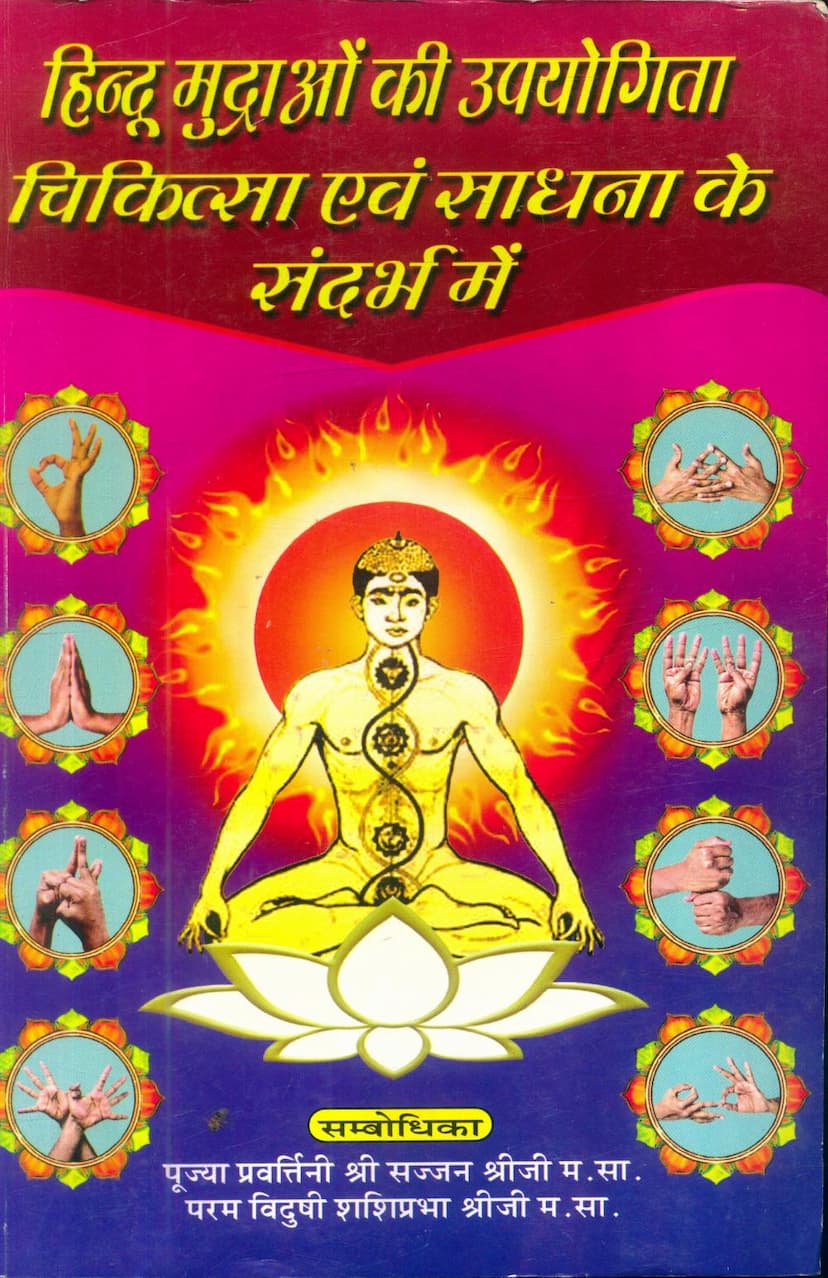Hindu Mudrao Ki Upayogita Chikitsa Aur Sadhna Ke Sandarbh Me
Added to library: September 1, 2025

Summary
Here's a comprehensive summary of the Jain text "Hindu Mudrao Ki Upayogita Chikitsa Aur Sadhna Ke Sandarbh Me" (The Utility of Hindu Mudras in the Context of Healing and Spiritual Practice) by Saumyagunashreeji, published by Prachya Vidyapith:
Overall Scope and Purpose:
This extensive work, presented as a D.Litt. thesis by Dr. Sadhvi Saumya Guna Shri, is a detailed comparative and critical study of Hindu mudras within the framework of Jain legal and ritualistic practices. The book aims to explore the utility of Hindu mudras in the context of both healing (chikitsa) and spiritual practice (sadhana). It delves into the scientific, psychological, and spiritual aspects of these hand gestures, drawing parallels and contrasts with Jain traditions and other Indian philosophies.
Key Themes and Content:
The book is structured into seven chapters, covering a wide range of information about mudras:
- Chapter 1: Specific Effects of Mudras on the Seven Chakras and Other Centers: This foundational chapter explains the concept of mudras as a yogic practice that can influence the subtle energy system of the body, including the seven chakras (Mooladhar, Swadhisthan, Manipur, Anahata, Vishuddhi, Ajna, and Sahasrar). It details how mudras can activate and balance these energy centers, leading to physical, mental, and spiritual well-being. The chapter also discusses the impact of mudras on endocrine glands, consciousness centers, and the five elements (Panch Mahabhutas).
- Chapter 2: Relevant Forms of Mudras Used in Various Activities of the Hindu Tradition: This chapter focuses specifically on Hindu mudras, describing their utility in various religious and cultural practices. It presents 35 different Hindu mudras with their methods of execution and their respective benefits, linking them to specific chakras, elements, glands, and affected body parts.
- Chapter 3: Purposeful Forms of Mudras Mentioned in Preceding Texts like Sharada Tilak and Prapanchasar: This chapter delves into ancient and influential texts like Sharada Tilak Tantra and Prapanchasar, which contain detailed descriptions of various mudras. It highlights mudras prescribed for specific rituals, deity worship, and tantric practices, offering insights into their symbolic meanings and applications. The chapter includes descriptions of mudras mentioned in Matanga Parameshvara, Sharada Tilak Tantra, and Raghavabhatta's commentary.
- Chapter 4: Mysterious Methods of Mudras Useful in Gayatri Mantra Sadhana and Sandhya Karma: This chapter specifically addresses the application of mudras in prominent Hindu practices like Gayatri Mantra Japa and Sandhya Karma. It outlines 24 mudras performed before the Gayatri Japa and 8 performed afterward, explaining their role in enhancing the spiritual efficacy of these practices. The chapter also touches upon their medicinal benefits.
- Chapter 5: Usage Methods of Mudras Prevalent in Worship and Other Rituals: This extensive chapter details mudras used in various Hindu worship rituals. It covers mudras associated with Shadanga Nyas (six limb-based placements), Jivan-nyas (life placement), Karanyas (hand placement), Matrika Nyas (mother-goddess script placement), Nitya Puja (daily worship), Puja-upachar (worship procedures), Dhyanavesh Prarthana (meditative prayers), and Homa (fire rituals). It also includes mudras associated with Goddess Saraswati, Lord Vishnu, and Lord Shiva, along with miscellaneous mudras.
- Chapter 6: Forms and Utility of Mudras Prevalent in Hindu and Buddhist Traditions: This chapter explores the shared practices of mudras in both Hindu and Buddhist traditions, highlighting their commonalities and differences. It describes mudras like Abhishek, Varad, Anjali, Ardhachandra, Namaskar, Netra, Padmahasta, Suchi, Lolhastas, Swastika, Tarjani, and others, noting their significance and applications in both spiritual and ritualistic contexts.
- Chapter 7: Conclusion: Mudras Useful in Physical and Spiritual Healing: This concluding chapter summarizes the practical application of mudras for both physical and spiritual well-being. It provides a comprehensive chart linking specific mudras to various physical and mental ailments, emphasizing their therapeutic potential. The chapter underscores the importance of proper technique, faith, and regularity in achieving the full benefits of mudra practice.
Key Highlights and Contributions:
- Comparative Study: A significant contribution of the book is its comparative analysis of mudras across different Indian traditions, particularly between Hindu and Jain practices, and also drawing connections with Buddhist traditions.
- Therapeutic and Spiritual Applications: The work extensively details the healing properties of mudras, linking them to specific physical ailments and psychological imbalances, alongside their role in spiritual advancement and chakra activation.
- Detailed Descriptions and Illustrations: The book provides detailed descriptions of how to perform each mudra, often referencing specific texts. While the text itself doesn't contain physical illustrations, it often refers to accompanying illustrations that would typically be present in such a book.
- Textual Basis: The author draws heavily from ancient texts like Sharada Tilak Tantra, Prapanchasar, and other yogic and tantric literature, grounding the information in traditional knowledge.
- Holistic Approach: The book adopts a holistic approach, recognizing the interconnectedness of the body, mind, and spirit, and how mudras can positively influence all these aspects.
- Academic Rigor: As a D.Litt. thesis, the work demonstrates significant academic depth, thorough research, and a systematic presentation of complex information.
- Contribution to Jain and Indian Studies: This research significantly contributes to the understanding of ritualistic practices and their scientific underpinnings within Jainism and broader Indian culture, particularly in the under-researched area of mudra science.
Overall Impression:
"Hindu Mudrao Ki Upayogita Chikitsa Aur Sadhna Ke Sandarbh Me" is an encyclopedic and scholarly work that provides a deep dive into the multifaceted world of mudras. It serves as a valuable resource for anyone interested in Indian traditional practices, healing modalities, and spiritual disciplines, offering a bridge between ancient wisdom and modern understanding. The author's dedication to research and her ability to present complex information clearly make this book a significant contribution to the field.